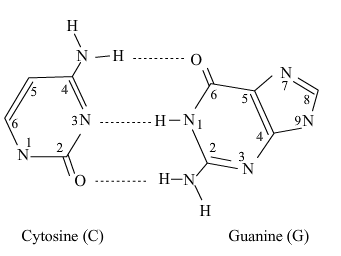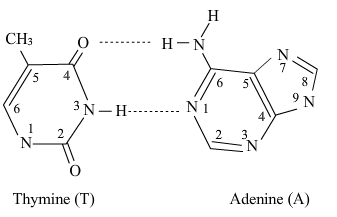Question
Question: The number of hydrogen bonds between Guanine and Cytosine; and between Adenine and Thymine in DNA ar...
The number of hydrogen bonds between Guanine and Cytosine; and between Adenine and Thymine in DNA are:
A.1,2
B.3,2
C.3,1
D.2,1
Solution
Nucleic acids are organic atoms basic for known types of life on this planet; they incorporate DNA (deoxyribonucleic acid) and RNA (ribonucleic acid). Along with proteins, nucleic acids are the most significant organic macromolecules; each is found in abundance in every living thing, where they work in encoding, communicating, and expressing hereditary data.
Complete answer:
The guanine forms three hydrogen bonds with the cytosine because, In cytosine, the amino group acts as the hydrogen bond donor and the C-2 carbonyl and the N-3 amine as the hydrogen-bond acceptors and in Guanine the group at C-6 acts as the hydrogen bond acceptor, while the group at N-1 and the amino group at C-2 act as the hydrogen bond donors.

The adenine forms two hydrogen bonds with the thymine as the only group at N-3 and carbonyl group at C-4 in Thymine form the hydrogen bond with the amino group at C-6 and group at N-1 of the adenine.

Therefore, the number of hydrogen bonds between Guanine and Cytosine; and between Adenine and Thymine in DNA are 3 and 2 respectively.
Hence, the correct option is B.
Note: The possibility to make a mistake is that Guanine always makes a pair with Cytosine and Adenine with Thymine whereas in RNA Adenine makes a bond with Uracil, not Thymine.
